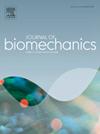Freezing negatively impacts the interlamellar mechanical properties of the degenerated human annulus fibrosus
IF 2.4
3区 医学
Q3 BIOPHYSICS
引用次数: 0
Abstract
Mechanical testing of biological tissues often utilizes previously frozen samples but there are conflicting reports about the impact of freezing on mechanical properties. There are no current studies examining the impact of freezing on the interlamellar matrix in the annulus fibrosus of intervertebral disc. We quantified the freezing-induced changes in the interlamellar mechanical properties of degenerated human and non-degenerated bovine annulus fibrosus tissues. Fresh human annulus fibrosus samples were obtained from surgical cases involving disc degeneration (loss of disc height with no deformities), degenerative scoliosis, degenerative spondylolisthesis, and isthmic spondylolisthesis, while bovine samples served as controls. The fresh samples were tested immediately following tissue resection whereas frozen samples were stored at −20 °C for three weeks before testing. An interlamellar peel test was performed where the lamellae were peeled at 0.5 mm/s until complete separation. In paired (same individual) and unpaired (different individuals) degenerated human samples, frozen tissues showed statistically significant decreases: Peel Stiffness (50 % and 36 %), Peel Strength (37 % and 45 %), and Standard Deviation of Peel Stress in the Peel Region (57 % and 55 %), with decreasing trends for Peel Toughness (41 % and 42 %), compared to fresh tissues. In contrast, non-degenerated bovine paired samples showed no significant differences between fresh and frozen groups. The results suggest that freezing negatively impacts interlamellar matrix properties in degenerated human annulus fibrosus, which may be exacerbated by existing tissue defects. In the future, annulus fibrosus samples may be best tested fresh to fully capture mechanical differences of the interlamellar matrix between clinical groups.
冷冻对退行性人纤维环的层间力学性能有负面影响
生物组织的力学测试通常使用先前冷冻的样品,但关于冷冻对机械性能的影响有相互矛盾的报道。目前还没有研究检查冷冻对椎间盘纤维环层间基质的影响。我们量化了冷冻诱导的变性人和非变性牛纤维环组织层间力学性能的变化。新鲜的人体纤维环样本来自于涉及椎间盘退变(椎间盘高度丧失但无畸形)、退行性脊柱侧凸、退行性椎体滑脱和峡部椎体滑脱的手术病例,而牛样本作为对照。新鲜样品在组织切除后立即进行测试,而冷冻样品在测试前在- 20°C保存三周。进行层间剥离试验,以0.5 mm/s的速度剥离片层,直到完全分离。在成对(同一个体)和未成对(不同个体)退化的人类样本中,冷冻组织显示出统计学上显著的降低:剥离刚度(50%和36%),剥离强度(37%和45%),剥离区域剥离应力的标准偏差(57%和55%),与新鲜组织相比,剥离韧性(41%和42%)呈下降趋势。相比之下,未退化的牛配对样品在新鲜组和冷冻组之间没有显着差异。结果表明,冷冻对退行性人纤维环的层间基质性能有负面影响,并可能因存在组织缺陷而加剧。在未来,纤维环样本最好是新鲜测试,以充分捕获临床组间板间基质的力学差异。
本文章由计算机程序翻译,如有差异,请以英文原文为准。
求助全文
约1分钟内获得全文
求助全文
来源期刊

Journal of biomechanics
生物-工程:生物医学
CiteScore
5.10
自引率
4.20%
发文量
345
审稿时长
1 months
期刊介绍:
The Journal of Biomechanics publishes reports of original and substantial findings using the principles of mechanics to explore biological problems. Analytical, as well as experimental papers may be submitted, and the journal accepts original articles, surveys and perspective articles (usually by Editorial invitation only), book reviews and letters to the Editor. The criteria for acceptance of manuscripts include excellence, novelty, significance, clarity, conciseness and interest to the readership.
Papers published in the journal may cover a wide range of topics in biomechanics, including, but not limited to:
-Fundamental Topics - Biomechanics of the musculoskeletal, cardiovascular, and respiratory systems, mechanics of hard and soft tissues, biofluid mechanics, mechanics of prostheses and implant-tissue interfaces, mechanics of cells.
-Cardiovascular and Respiratory Biomechanics - Mechanics of blood-flow, air-flow, mechanics of the soft tissues, flow-tissue or flow-prosthesis interactions.
-Cell Biomechanics - Biomechanic analyses of cells, membranes and sub-cellular structures; the relationship of the mechanical environment to cell and tissue response.
-Dental Biomechanics - Design and analysis of dental tissues and prostheses, mechanics of chewing.
-Functional Tissue Engineering - The role of biomechanical factors in engineered tissue replacements and regenerative medicine.
-Injury Biomechanics - Mechanics of impact and trauma, dynamics of man-machine interaction.
-Molecular Biomechanics - Mechanical analyses of biomolecules.
-Orthopedic Biomechanics - Mechanics of fracture and fracture fixation, mechanics of implants and implant fixation, mechanics of bones and joints, wear of natural and artificial joints.
-Rehabilitation Biomechanics - Analyses of gait, mechanics of prosthetics and orthotics.
-Sports Biomechanics - Mechanical analyses of sports performance.
 求助内容:
求助内容: 应助结果提醒方式:
应助结果提醒方式:


